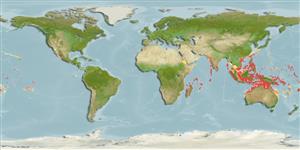>
Kurtiformes (Nurseryfishes, cardinalfishes.) >
Apogonidae (Cardinalfishes) > Pseudamiinae
Etymology: Pseudamia: Greek, pseudes = false + Greek, amia = a kind of shark (Ref. 45335).
Eponymy: Dr Masayoshi Hayashi is Curator, Yokosuka City Museum. [...] (Ref. 128868), visit book page.
More on authors: Randall, Lachner & Fraser.
Environment: milieu / Klimaatzone / Diepte / distribution range
Ecologie
marien rifbewoner; diepte 2 - 64 m (Ref. 11890). Tropical; 32°N - 28°S
Indo-Pacific: Gulf of Aden to Samoa, north to southern Japan, south to Western Australia.
Grootte / Gewicht / Leeftijd
Maturiteit: Lm ? range ? - ? cm
Max length : 10.0 cm TL mannelijk / geslacht onbekend; (Ref. 48635)
Dorsale stekels (totaal) : 7; Dorsale zachte stralen (totaal) : 8; Anale stekels: 2; Anale zachte stralen: 7 - 8; Wervels: 24. Translucent when fresh with a reddish cast, overlaid with iridescence particularly on abdomen and operculum predominated by golden hues; dusky caudal fin with hyaline border; 1st and 2nd dorsal and anal fin pale to dusky or blackish, other fins are clear with pink rays. Anterior nostril without long flap. Rhomboid caudal fin. 23-24 scales in longitudinal series. Gill rakers 4-5+11-13, 1-7 developed. Convex interorbital space. Oblique mouth. Predorsal scales 10 (9-11). This species resembles P. amblyuroptera and P. gelatinosa but has larger scales (LR<=24) (Ref. 37816).
Body shape (shape guide): elongated; Cross section: compressed.
Inhabits lagoon and seaward reefs; hides in small caves and under ledges. Solitary and usually seen at night (Ref 90102).
Levenscyclus en paargedrag
Maturiteit | Voortplanting | Paaien | Eieren | Fecunditeit | Larven
Distinct pairing during courtship and spawning (Ref. 205).
Randall, J.E., E.A. Lachner and T.H. Fraser, 1985. Revision of the Indo-Pacific apogonid fish genus Pseudamia, with descriptions of three new species. Indo-Pac. Fish. 6:1-23. (Ref. 526)
Status op de Rode Lijst van het IUCN (Ref. 130435: Version 2025-1)
Gevaar voor de mens
Harmless
Gebruik door de mens
Tools
Speciale rapporten
Download XML
Internetbronnen
Estimates based on models
Preferred temperature (Ref.
123201): 26.2 - 29, mean 27.9 °C (based on 664 cells).
Fylogenetische diversiteitsindex (Ref.
82804): PD
50 = 0.5078 [Uniqueness, from 0.5 = low to 2.0 = high].
Bayesian length-weight: a=0.00389 (0.00180 - 0.00842), b=3.12 (2.94 - 3.30), in cm total length, based on all LWR estimates for this body shape (Ref.
93245).
Trofisch niveau (Ref.
69278): 3.5 ±0.50 se; based on food items.
Weerstandsvermogen (Ref.
120179): Hoog, minimale populatieverdubbelingstijd minder dan 15 maanden (Preliminary K or Fecundity.).
Fishing Vulnerability (Ref.
59153): Low vulnerability (10 of 100).
🛈
Nutrients (Ref.
124155): Calcium = 162 [85, 278] mg/100g; Iron = 0.974 [0.560, 1.649] mg/100g; Protein = 18.5 [17.3, 19.6] %; Omega3 = 0.113 [0.063, 0.210] g/100g; Selenium = 39.2 [18.0, 85.9] μg/100g; VitaminA = 81.7 [26.0, 249.9] μg/100g; Zinc = 2.04 [1.32, 3.00] mg/100g (wet weight);
